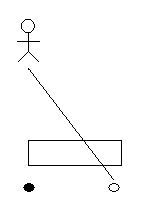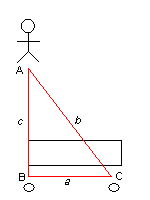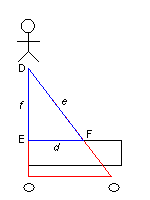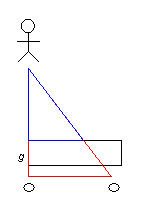A Cardboard Rangefinder for Scale Focusing Cameras
I got the idea for this from an article at photo.net. There is a good on-line calculator also. Thanks to J.L. for sending me these links. I had forgotten where I saw them
Many inexpensive cameras, especially from the 1940s and 1950s, use a type of focusing called "scale focus" or "zone focus." These cameras have an adjustable focus, but lack a focusing aid such as a rangefinder. You have to determine the distance to the subject and set the focus using a scale printed on the lens. If you are good at estimating distances, or have a tape measure at hand, you can get precise, sharp focus with one of these cameras. Optionally, you can set the lens to the hyper-focal distance for your chosen aperture and use the camera as a point-and-shoot. But what you really need is a rangefinder to calculate the distance for you. Sometimes you can find a clip-on rangefinder, but they are difficult to find and often cost more than the camera. Instead, we can make a rangefinder out of a piece of cardboard that will work reasonably well.
Try this: Close your right eye and hold a small card, such as a business card, at arms length so that the left edge of the card is aligned with a target. Next, close your left eye and open your right eye and you will see the target appear to move along the edge of the card.


The distance the object will appear to move depends on the distance between your eyes, the length of your arm and the distance to the target. Using the parallax between the two eyes we can construct a device to approximate distances. First, we need to do a little geometry..
A right triangle is formed with the lines between your eyes and the target (A,B,C). A second right triangle is formed with the lines from the target to the card and the distance along the edge of the card where the target appears to intersect (D,E,F).



We know that since the angles of the two triangles are the same, then the ratio of the sides is the same as well. Thus:
a/c = d/f
Solving for d, we get:
d = a(f/c)
The distance from your left eye to the target is c (the focusing distance), the distance between your eyes is a, the length of your arm is g and the distance from the card to the target, f = c - g. To make the rangefinder, we need to calculate the distance along the edge of the card (d) for each focusing distance marked on the camera's scale (c) and then mark the card for each value.
d = (a (c - g)) / c
On the card, write the focusing distance for each calculated value of d. Once you have marked the card, hold the card at arms length so that the left edge of the card is aligned with the target with you right eye closed. Open your right eye and close your left eye, then read the distance off the card where you see the target. Transfer the distance to the focusing scale on the camera and you're ready to shoot.
The shortest distance you can measure is the length of your arm. Generally, these types of cameras won't focus closer that three feet (1 meter), so that's not a problem for most of us. As the distance to the target increases, the distance along the card gets shorter. As a result it is difficult to get accurate measurements beyond twenty feet and almost impossible to get measurements beyond fifty feet. Fortunately, a normal lens will be very close to infinity beyond fifty feet and depth of field will increase with distance. So, the sharpness of the picture is not affected very much by errors at longer distances. Here is a scan of the rangefinder I made. (I used a computer graphics editor that can specify precise measurements, but it's easy to do by hand.) I used colored markers to help discriminate at the longer distances.

You can reverse the whole setup if you want so that you align the right edge of the card with your right eye and then read the distance with your left eye. You just have to mark the card from right to left.